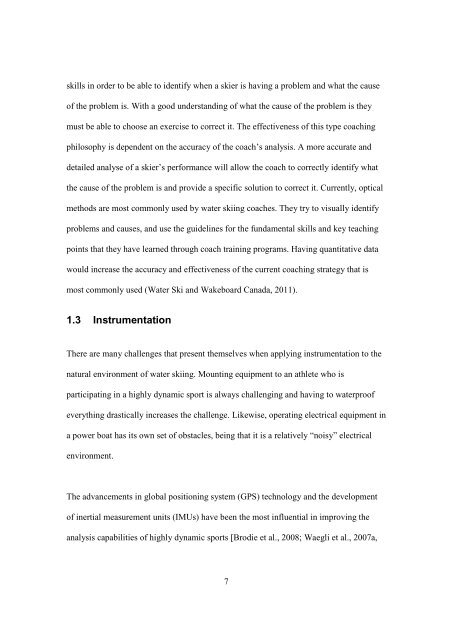Biomechanical P ... Slalom Water Skiing R1.pdf - Atrium - University ...
Biomechanical P ... Slalom Water Skiing R1.pdf - Atrium - University ...
Biomechanical P ... Slalom Water Skiing R1.pdf - Atrium - University ...
- No tags were found...
Create successful ePaper yourself
Turn your PDF publications into a flip-book with our unique Google optimized e-Paper software.
skills in order to be able to identify when a skier is having a problem and what the causeof the problem is. With a good understanding of what the cause of the problem is theymust be able to choose an exercise to correct it. The effectiveness of this type coachingphilosophy is dependent on the accuracy of the coach’s analysis. A more accurate anddetailed analyse of a skier’s performance will allow the coach to correctly identify whatthe cause of the problem is and provide a specific solution to correct it. Currently, opticalmethods are most commonly used by water skiing coaches. They try to visually identifyproblems and causes, and use the guidelines for the fundamental skills and key teachingpoints that they have learned through coach training programs. Having quantitative datawould increase the accuracy and effectiveness of the current coaching strategy that ismost commonly used (<strong>Water</strong> Ski and Wakeboard Canada, 2011).1.3 InstrumentationThere are many challenges that present themselves when applying instrumentation to thenatural environment of water skiing. Mounting equipment to an athlete who isparticipating in a highly dynamic sport is always challenging and having to waterproofeverything drastically increases the challenge. Likewise, operating electrical equipment ina power boat has its own set of obstacles, being that it is a relatively “noisy” electricalenvironment.The advancements in global positioning system (GPS) technology and the developmentof inertial measurement units (IMUs) have been the most influential in improving theanalysis capabilities of highly dynamic sports [Brodie et al., 2008; Waegli et al., 2007a,7
















